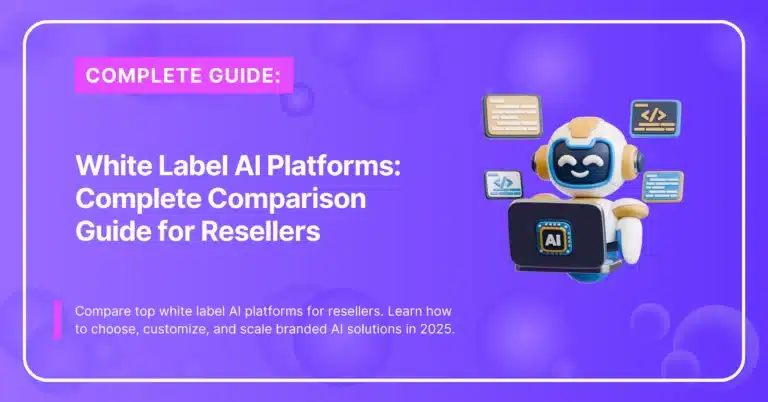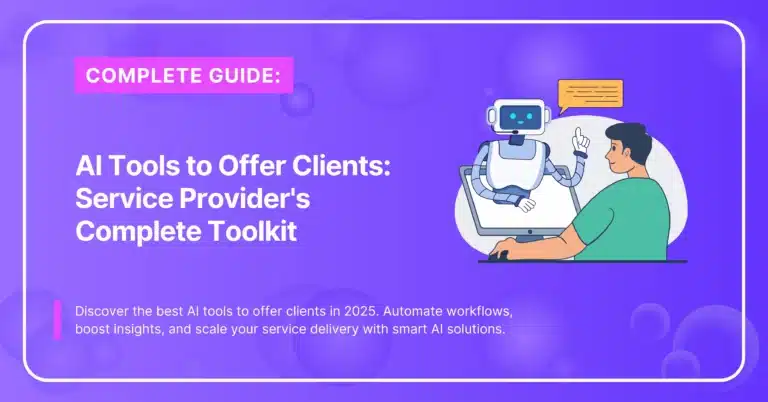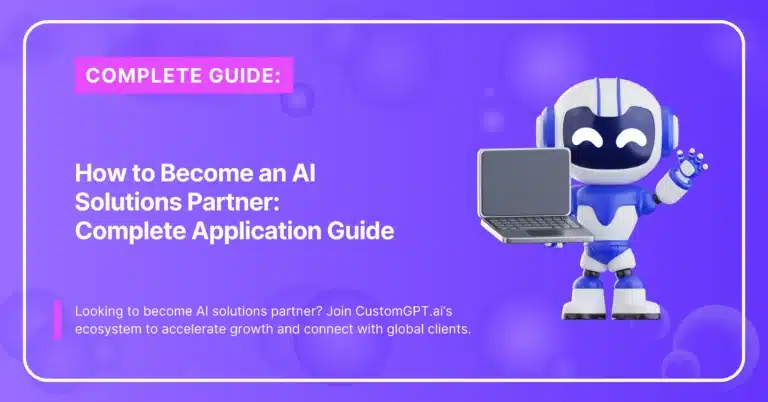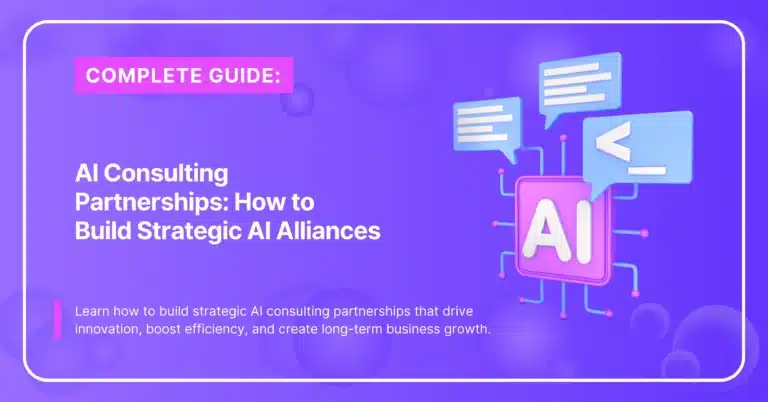Consulting has always been about expertise, insight, and trust. But in 2025, a new player has entered the room: artificial intelligence.
Firms that once relied solely on human judgment are now discovering how AI for consulting firms can analyze mountains of data in seconds, automate repetitive tasks, and surface insights no team of analysts could find on their own.

Make Money With AI
Join our Partner Programs!
Boost your reputation, drive revenue and grow your business with CustomGPT.ai.
The results are already impressive—faster projects, leaner operations, and happier clients. The real question isn’t whether consulting firms should adopt AI, but how to do it strategically, without losing the human touch that defines the profession.
In this guide, we’ll walk you through the fundamentals of AI in consulting, high-impact use cases, integration strategies, and real-world examples to help you build a roadmap for sustainable success.
AI Fundamentals for Consulting
Artificial intelligence may sound futuristic, but its role in consulting is surprisingly practical. At its core, AI helps consultants work smarter: processing vast amounts of information, highlighting patterns, and providing a foundation for better decision-making.
To use AI effectively, consulting firms need to master three fundamentals—interpretability, adaptability, and scalability.
Interpretability: Building Client Trust
In consulting, trust is everything. If an AI system produces recommendations without clear reasoning, clients are less likely to accept them. That’s why interpretability—the ability to explain how an AI model reaches its conclusions—is non-negotiable.
In sectors like finance and healthcare, consultants must be able to show not only what the model predicts, but why.
Adaptability: Learning and Refining
AI is not a static tool—it improves over time. Early models may misclassify data or overlook nuances, but with iterative refinement and client-specific inputs, accuracy increases dramatically.
For example, Deloitte and other firms emphasize that continuous model refinement and feedback loops can significantly reduce error rates over time, improving interpretability, trust, and outcome reliability.
This ability to learn ensures AI remains relevant across diverse industries and use cases.
Scalability: Expanding Across Clients
A model that works for one client may struggle with another due to differences in data quality, workflows, or industry context. To address this, firms are increasingly adopting modular AI architectures.
By breaking down systems into interchangeable components—such as data preprocessing, feature selection, or reporting—consultants can adapt solutions without starting from scratch.
This scalability turns AI into a repeatable asset, not a one-off experiment.
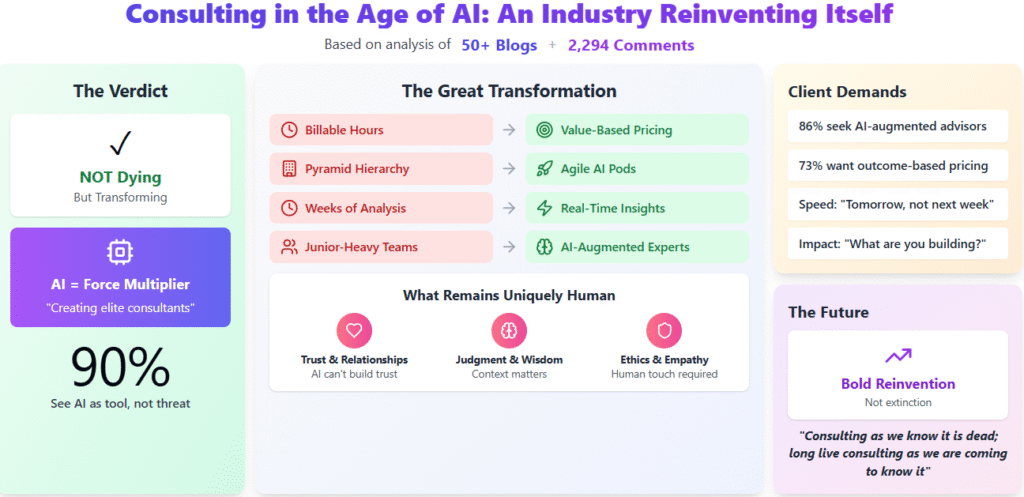
Aligning AI with Business Strategy
The real power of AI in consulting doesn’t come from technology alone—it comes from aligning AI initiatives with business goals. Without this connection, AI risks becoming a shiny experiment rather than a driver of measurable client value.
Value-Driven Integration
Every AI project should start with a simple question: What business problem are we solving? By tying AI initiatives directly to outcomes like cost reduction, revenue growth, or operational efficiency, firms ensure that technology enhances strategy rather than distracting from it.
PwC offers a strong example: by implementing AI-driven predictive analytics in supply chain consulting, they reduced client inventory costs by 15% while improving order fulfillment. The success wasn’t about the tool itself—it was about targeting a clear business challenge with a measurable outcome.
Mapping Workflows for Impact
Consulting firms can identify where AI will create the most value by mapping client workflows end-to-end. This process reveals inefficiencies, bottlenecks, and repetitive tasks that AI can optimize.
The key is to focus first on areas where high returns meet low implementation complexity, ensuring early wins that build client trust and organizational buy-in.
A Dual Evaluation Framework
Not all opportunities are created equal. A structured framework helps firms evaluate both technical feasibility (data quality, system integration, scalability) and strategic alignment (fit with KPIs, client priorities, and firm capabilities).
This dual assessment prevents wasted effort on technically impressive but strategically irrelevant projects.
As Dr. Alan Hughes, Chief Data Officer at Global Insights Group, explains:
“AI’s strategic alignment is not just about technology—it’s about embedding intelligence into decision-making frameworks.”
By approaching AI through a business-first lens, consulting firms transform it from a tool into a competitive advantage.
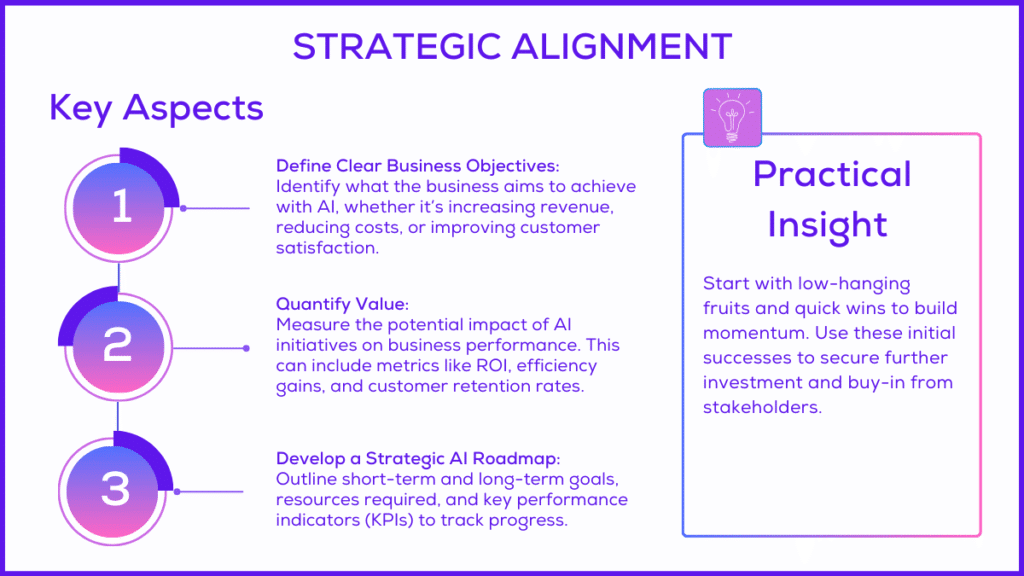
Developing an AI Strategy
AI adoption in consulting succeeds when it’s built on a clear roadmap that links technology to measurable client outcomes. Without this structure, projects risk stalling at the pilot stage or failing to scale.
Identifying High-Impact Use Cases
The first priority is deciding where AI can make the biggest difference. Not every process benefits equally—some are too complex, while others are too simple to justify automation. The sweet spot is finding tasks that are repetitive, time-consuming, and high in client value.
- Examples include automating compliance reviews, streamlining onboarding, or analyzing large datasets for patterns.
- Starting with these “quick wins” delivers visible ROI and builds confidence to expand into more advanced applications.
In legal and compliance-adjacent work, for example, AI document analysis routinely yields tangible time savings: Womble Bond Dickinson reports 20–60% reductions in contract-review time using Kira—freeing experts for higher-value judgment work.
To keep momentum, apply a simple value vs. complexity screen and prioritize the high-ROI, low-integration items first.
McKinsey’s 2024–2025 data shows adoption is rising across functions, but scaling requires focus—organizations that expand AI beyond a single area typically standardize on a few high-leverage patterns and grow from there.
Feasibility Analysis and Resource Planning
Even a promising use case can fail if the firm isn’t ready to support it. Feasibility checks help avoid costly mistakes.
- Data readiness: Is clean, usable data available?
- System capacity: Can existing tools integrate with AI solutions?
- Talent mix: Do we have staff who understand both consulting workflows and AI tools—or do we need outside expertise?
By answering these questions upfront, firms avoid underestimating the effort and can plan resources effectively.
Multiple surveys highlight the scaling gap: McKinsey notes that even “high performers” struggle to organize unstructured data; only 31% use a component-based approach that makes scaling easier, and 60–80% struggle with unstructured-data strategy.
Technical Integration and Data Governance
AI has little value if it can’t connect with the systems consultants already use. Integration also brings responsibility for how data is managed.
- Middleware and APIs can bridge gaps between modern AI tools and older platforms.
- Governance frameworks—rules for cleaning, storing, and accessing data—ensure results are reliable and compliant.
- When integration and governance are built in from the start, AI becomes a trusted part of everyday consulting work rather than a standalone experiment.
Building a Robust Data Architecture
Consulting firms often deal with fragmented client data spread across spreadsheets, emails, and disconnected databases. This slows projects and creates inconsistencies.
- A modular architecture—separating data collection, cleaning, and storage—provides flexibility.
- Standardizing formats and centralizing access create a “single source of truth.”
- With solid foundations, AI projects scale faster and more smoothly across clients.
Ensuring Data Security and Compliance
Security and compliance aren’t optional—they’re central to client trust. Mishandling sensitive information can damage relationships overnight.
- Techniques like anonymization and federated learning reduce risk by protecting raw client data.
- Aligning with regulations such as GDPR or HIPAA safeguards both clients and the firm.
- Embedding compliance early reassures clients that innovation doesn’t compromise responsibility.
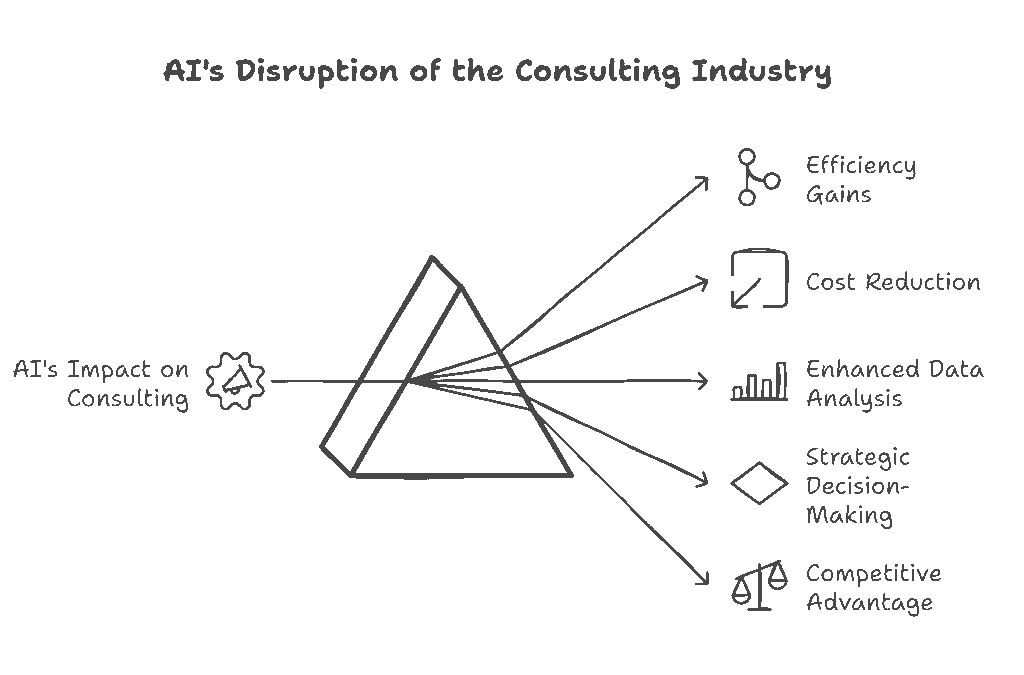
Image source: notta.ai
Custom Model Development
Off-the-shelf AI tools can help, but consulting firms often need solutions that fit unique client challenges. Custom model development allows firms to tailor AI to specific industries, datasets, and workflows.
The key is building models that are not only accurate but also trustworthy and easy for clients to understand.
Algorithm Selection and Model Training
Choosing the right algorithm is like picking the right tool for a project—some are powerful but complex, while others are simpler and easier to explain.
- Neural networks handle unstructured data (like text or images) but can be difficult to interpret.
- Decision trees and gradient boosting are more transparent and often better suited to consulting, where clients need clear reasoning behind recommendations.
- Training cycles should be iterative: start small, test performance, and refine with each round.
The goal isn’t just technical accuracy but finding a balance between complexity, interpretability, and client trust.
Interpreting and Validating AI Models
Even the best algorithm won’t succeed if clients don’t trust the output. Validation ensures models behave reliably under real-world conditions.
- Explainability tools like LIME or SHAP can break down why the model made a certain prediction. This is especially important in regulated industries like finance or healthcare.
- Stress testing with unusual or “edge case” data uncovers weaknesses before deployment.
- Continuous validation helps maintain accuracy over time as client data and conditions change.
By prioritizing interpretability and validation, consulting firms can position AI not as a black box but as a transparent, reliable partner in decision-making.

Continuous Monitoring and Improvement
Once an AI system is live, the real work begins. Consulting firms must ensure that models stay accurate, relevant, and aligned with client needs as data, markets, and regulations evolve. Without continuous monitoring, performance can quickly drift.
Adaptive Observability and Live Metrics
Traditional dashboards often track only static metrics, but AI requires more adaptive monitoring.
- Beyond accuracy: Track not only how well the model predicts but also whether it aligns with business goals (e.g., faster client reporting, better compliance checks).
- Custom dashboards: Build live views of critical indicators like error rates, response times, and user engagement.
- Industry awareness: Incorporate client-specific contexts, such as seasonal demand shifts or new regulations, into monitoring.
Adaptive observability ensures the system reflects real-world conditions, not just lab results.
Real-Time Anomaly Detection and Contextual Updates
AI models naturally degrade over time as data changes — a phenomenon known as drift.
- Anomaly detection: Use monitoring systems that flag unusual patterns in data or predictions.
- Automated retraining: Trigger updates when performance drops below agreed thresholds.
- Contextual validation: Before full rollout, test updates with controlled groups (canary testing) to avoid large-scale failures.
This continuous improvement cycle keeps AI systems fresh, effective, and trusted by both consultants and clients.
Measuring ROI and Business Impact
AI in consulting isn’t just about technical performance — it’s about proving business value. Clients want to know: Is this worth the investment?
Measuring ROI means looking at both financial returns and broader outcomes like client satisfaction and long-term adaptability.
Financial Metrics and Operational KPIs
Firms should combine traditional financial indicators with operational measures to capture the full picture.
- Cost savings: Reduction in manual labor, compliance overhead, or inefficiencies.
- Revenue growth: New services or faster delivery times that bring in additional business.
- Operational KPIs: Metrics like time-to-decision, error reduction, or process efficiency improvements.
Tracking these indicators provides tangible evidence of AI’s contribution to the bottom line.
Client-Centric Outcomes and Long-Term Value
Numbers matter, but consulting is ultimately about client trust and relationships.
- Client retention: Higher satisfaction rates and repeat business after AI adoption.
- Decision speed and quality: Faster insights that help clients act with confidence.
- Adaptability: AI systems that evolve with changing data, markets, or regulations.
- Qualitative feedback: Structured interviews and surveys that capture intangible benefits like improved transparency.
By blending hard metrics with client-centered outcomes, consulting firms can show that AI delivers both immediate ROI and long-term strategic value
Overcoming Challenges in AI Adoption
Adopting AI in consulting isn’t without hurdles. Firms face not only technical barriers but also organizational and ethical ones. Addressing these challenges early is key to sustainable success.
Ethical & Legal Considerations
AI systems deal with sensitive data and decisions that impact clients. Missteps can damage trust or lead to compliance issues.
- Transparency: Ensure clients understand how AI makes decisions.
- Bias prevention: Regularly audit models to avoid unfair or discriminatory outcomes.
- Regulatory compliance: Stay aligned with frameworks like GDPR or HIPAA, depending on the industry.
Strong governance and open communication transform compliance into a trust-building advantage.
Organizational Resistance
Employees often fear change, and clients may worry about losing the “human touch.”
- Clear communication: Explain that AI supports consultants rather than replaces them.
- Training programs: Equip teams with the skills to oversee and interpret AI tools.
- Early wins: Start with small projects that deliver visible results, building momentum and confidence.
Change management is as important as technical deployment in ensuring adoption.
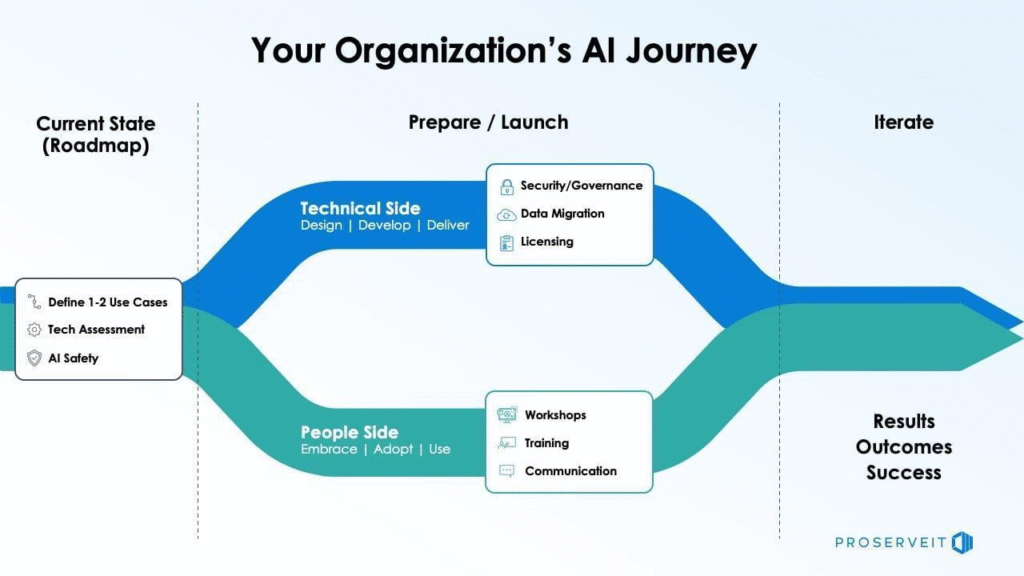
Change Management and Workforce Enablement
AI adoption isn’t just about technology — it’s about people. Consultants and their clients need to understand how AI will affect roles, workflows, and culture. Without proper change management, even the most advanced tools can fail.
Preparing the Workforce for AI Adoption
Employees often worry AI will replace their jobs. The truth is, AI usually augments work by taking over repetitive tasks and leaving space for higher-value activities. Preparing the workforce requires a mix of communication, training, and role adaptation.
- Skills mapping: Identify gaps between current employee capabilities and the new skills AI demands (like data interpretation and oversight).
- Targeted training: Use hands-on learning rather than just theory. For example, pair junior analysts with AI mentors to speed up adoption.
- Narrative reframing: Leaders should position AI as a tool for collaboration, not competition.
When employees feel empowered, not replaced, adoption rates and engagement increase.
Integrating AI into Existing Processes
Dropping AI into a firm’s operations without planning leads to confusion. Instead, firms should introduce it gradually through modular improvements.
- Process mapping: Identify where AI adds the most value — often repetitive, time-consuming tasks like document review or data validation.
- Modular integration: Add AI into specific parts of workflows rather than replacing entire systems at once.
- Middleware solutions: Use APIs and orchestration tools to bridge gaps between legacy systems and AI tools.
This step-by-step integration helps minimize disruption while demonstrating early wins to stakeholders.
Post-Deployment Optimization
AI doesn’t end at launch — it needs continuous tuning to stay effective.
- Performance monitoring: Track key metrics like accuracy, speed, and reliability.
- Canary testing: Roll out updates to a small group first to catch issues before full deployment.
- Feedback loops: Collect input from employees and clients to refine workflows.
Optimization ensures AI continues to evolve alongside business needs rather than becoming outdated or misaligned.
Cost & ROI
AI projects can be expensive, and ROI may take time to materialize.
- Prioritization: Focus on high-value, low-complexity use cases first.
- Phased investment: Scale gradually, reinvesting early wins into more advanced projects.
- Partnerships: Work with AI solution providers to reduce upfront development costs and access proven tools.
By balancing ambition with practical steps, firms can control costs while demonstrating value early.
Scaling Consulting Success with CustomGPT.ai
The CustomGPT.ai Solutions Partner Program helps consulting firms implement AI seamlessly across their operations. By combining advanced technology with expert guidance, the program ensures that firms can adopt AI efficiently, remain compliant, and deliver measurable value to their clients.
Who the Program is For
- AI consultants & solution providers
- IT consultants & managed service providers
- Marketing & web development agencies
Key Benefits for Partners
- Revenue Growth: Up to 40% off annual plans for clients and a rev-share model on closed deals.
- Sales Enablement: Access to an enterprise-level demo account and early access to new features.
- Visibility: Featured in the CustomGPT.ai Solutions Directory, connecting you with qualified leads.
- Support: Dedicated account management, co-selling opportunities, and implementation coaching.
- Scalability: No-code deployment of secure, accurate AI solutions built with the industry’s #1 anti-hallucination algorithm.
How the Program Works
- Intro Call: Meet with the CustomGPT.ai partner team to map AI opportunities for your clients.
- 15-Day Trial: Explore client pain points, test solutions, and receive tailored coaching.
- Onboarding: Unlock discounted pricing, partner benefits, and collaborative growth opportunities.
What Partners Can Deliver with CustomGPT.ai
- AI as a Service: Add AI-driven chat, support, and workflow automation to client portfolios.
- New Revenue Streams: Generate recurring income through AI implementation, management, and analytics reviews.
- Enterprise-Grade AI: Deploy secure, accurate, and compliant AI that clients can trust.
- Faster Time-to-Value: Build and launch solutions without coding, so clients see results quickly.

Make Money With AI
Join our Partner Programs!
Boost your reputation, drive revenue and grow your business with CustomGPT.ai.
Real World Case Studies
Case Study: Generative Labs
Generative Labs accelerates AI adoption by delivering focused, iterative projects. Using CustomGPT.ai, they helped a consultancy implement compliance automation, reducing review times by 30% and laying the groundwork for broader AI initiatives.
Key Insight: With CustomGPT.ai, Generative Labs demonstrates how consulting firms can achieve rapid wins while preparing for long-term AI scalability.
Case Study: NetConnect Digital Agency
NetConnect uses CustomGPT.ai to deliver client-facing AI solutions in industries such as e-commerce and healthcare. By embedding AI-powered chatbots into an e-commerce client’s support system, they reduced response times, cut support costs, and boosted customer satisfaction.
Key Insight: With CustomGPT.ai, NetConnect delivers AI that enhances customer engagement and operational efficiency.
Future of AI in Professional Services
The consulting industry is entering a new phase where AI is no longer a back-office tool but a client-facing differentiator. Firms that invest early in scalable, trustworthy AI will be best positioned to lead the market.
Emerging Trends in AI for Consulting
Several AI innovations are set to redefine professional services in the coming years:
- Generative AI: From drafting client reports to creating tailored recommendations, generative AI will help firms deliver faster, more personalized outputs.
- Decision Intelligence: By combining data, predictive modeling, and scenario testing, AI will enhance strategic planning and risk analysis.
- AI Copilots: Embedded directly into workflows, AI assistants will guide consultants with real-time insights, reducing manual research and boosting productivity.
- Ethical AI Practices: Clients are demanding transparency, explainability, and fairness in AI-driven solutions, making governance and compliance a competitive advantage.
Staying Competitive with AI-Driven Strategies
To stay relevant, consulting firms need to move beyond experimentation and embed AI into their core business strategy. This means:
- Scaling AI Across Services: Expanding pilots into full-service offerings that directly impact client value.
- Upskilling Consultants: Training teams to interpret, validate, and optimize AI outputs while retaining human judgment.
- Client Co-Creation: Involving clients in the design of AI solutions to ensure adoption, trust, and measurable ROI.
- Partnership Ecosystems: Leveraging platforms like CustomGPT.ai and partner networks to accelerate deployment and reduce implementation risks.
The future will not be about whether consulting firms use AI, but how effectively they embed it into every aspect of client delivery.
Those that succeed will differentiate themselves not just by expertise, but by their ability to harness AI as a trusted partner in solving complex business problems.
FAQ
What are the key steps for consulting firms to implement AI effectively?
– Assess organizational readiness (data quality, infrastructure, skills).
– Identify high-impact use cases through workflow mapping.
– Start with pilot projects to validate performance.
– Ensure seamless integration with existing systems (e.g., CRMs, ERPs).
– Monitor results continuously with adaptive KPIs.
– Partner with trusted AI providers like CustomGPT.ai for scalable adoption.
What AI tools help consulting firms?
– Natural Language Processing (NLP): Automates document review, client onboarding, and compliance.
– Predictive Analytics: Supports forecasting, risk analysis, and strategic planning.
– AI Chatbots & Assistants: Enhance client engagement and support.
– CustomGPT.ai Platform: Provides enterprise-grade, anti-hallucination AI tailored for professional services.
How can consulting firms align AI with measurable business outcomes?
Link AI initiatives directly to client goals like cost savings, growth, or efficiency and use a value vs. complexity matrix to prioritize initiatives. Collect client feedback regularly to validate value creation.
What is the ROI of AI for consulting firms?
– Financial gains: Cost reduction and revenue growth.
– Operational impact: Faster decision-making, reduced manual work.
– Client value: Improved satisfaction, retention, and personalized solutions.
– Long-term advantage: Scalability, compliance readiness, and stronger competitive positioning.
How should consultants prepare for AI adoption?
– Upskill teams: Focus on data literacy, AI oversight, and interpretation.
– Redefine roles: Shift from manual tasks to higher-value advisory work.
– Adopt a growth mindset: View AI as augmentation, not replacement.
– Leverage training & support: Use partner programs like CustomGPT.ai for guided implementation and ongoing enablement.
Conclusion
AI is no longer an optional experiment for consulting firms—it is a strategic necessity. The firms that will thrive are those that integrate AI into their core services with purpose, transparency, and scalability.
By aligning AI with business goals, identifying high-impact opportunities, ensuring compliance, and empowering their workforce, consulting firms can turn AI into a true driver of competitive advantage.
The lesson is clear: AI will not replace consultants, but consultants who embrace AI will outpace those who do not.
If your firm is ready to move forward, CustomGPT.ai provides the technology, partner support, and expertise to make AI adoption seamless and impactful.
Explore the CustomGPT.ai Solutions Partner Program to unlock new revenue, deliver enterprise-grade AI, and position your consulting practice at the forefront of innovation.



